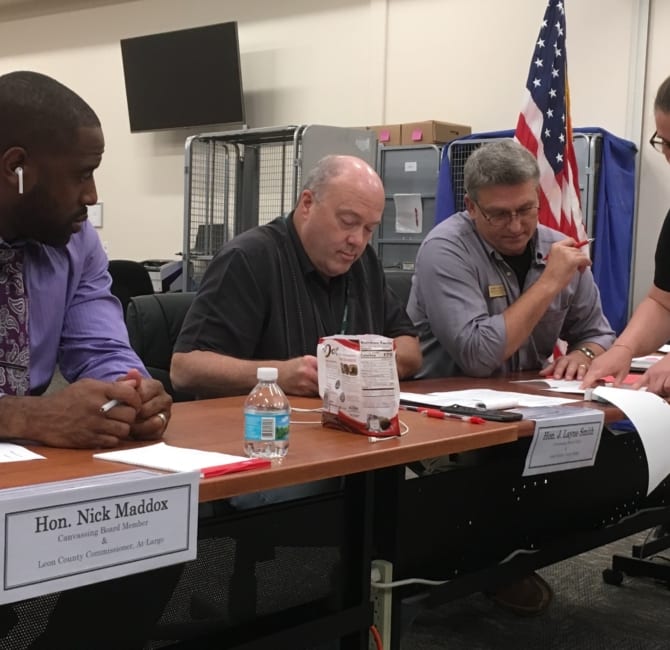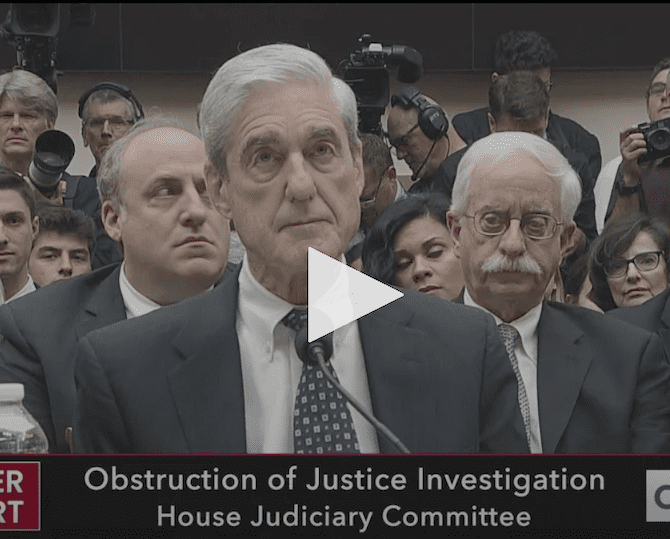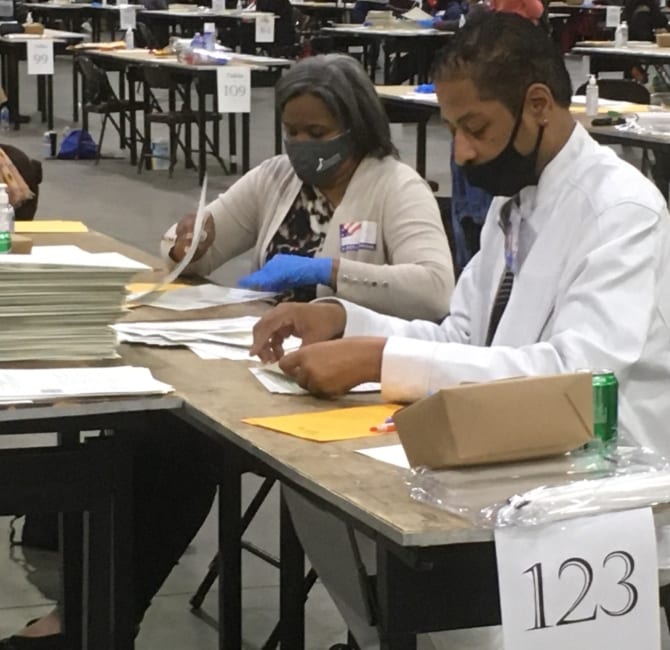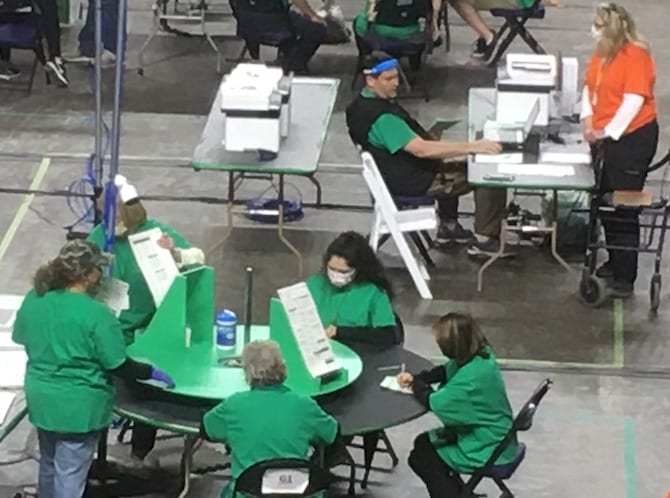As Arizona Wraps Up Hand Count of 2020 Ballots, New Questions About Accuracy Arise
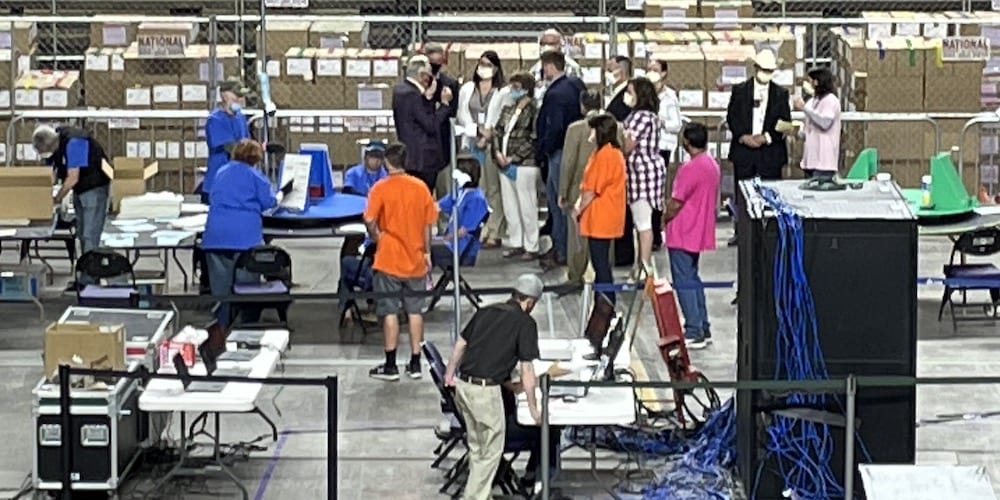
(Republicans visiting Arizona post-election investigation. Photo by Steven Rosenfeld)
The hand count of 2.1 million paper ballots from 2020’s presidential election in Arizona’s most populous county has reached a turning point. Inside Phoenix’s Veterans Memorial Coliseum, the last boxes of ballots—said by observers to hold the final votes that lifted Joe Biden to a 2020 victory in Maricopa County and statewide—have been manually tallied.
Now the process moves to assessing and working with the data from 70,000-plus hand count tally sheets; from verifying it was accurately entered into spreadsheets on computers in the arena, to the most consequential question. Are the reported results credible? If so, why? If not, why not?
Ken Bennett, Arizona’s former secretary of state and the state Senate’s liaison to the review sanctioned by GOP legislators, and StratTech Solutions, a subcontractor that took over the hand count midway through the process in May, will soon review the count’s data to assess its consistency, strengths and weaknesses.
“That’s exactly what I am trying to get to,” Bennett said on June 15. “I’m told that we have somewhere between 70,000 and 80,000 tally sheets I want to confirm. And it’s not just me. I’m told by the supervisors at [the] aggregation [tables], that they have been implementing quality control and verification techniques for several weeks.”
This assessment will spark politically charged questions. Arizona’s Republican Senate has called the hand count and other inquiries an audit. In the election world, vote count audits gain credibility by comparing independently collected evidence to as many points as possible in the building blocks of the official results. Those points include the paper ballot, its ink-marked votes, and a sequence of digital files that contain that vote count information. Like bricks in a pyramid, the votes are built into what becomes the official result of every race.
Critics have said the hand count in Phoenix is not an audit, but rather is a loose recount because it has not—or at least, not yet—produced or used many points of comparison with the building blocks of the official 2020 vote count. The video footage of busy workers on the arena floor obscures this bottom line, which seasoned election officials are aware of.
“I’m the Senate’s liaison to an audit, not the Senate liaison to a recount,” said Bennett, who, before his life in politics, was an accountant and CEO.
Audit or Recount?
The review’s top proponent, Arizona Senate President Karen Fann, has said that the Senate will issue a final report once all of its inquiries are done. She has also sanctioned a photography- and microscope-based review of the ink marks, folds, and paper fibers on the paper ballots to try to detect forgeries—responding to a conspiracy theory that has been widely promoted in pro-Trump circles.
But it is the hand count that most closely resembles normal post-Election Day protocols. Those steps include audits, ballot challenges, recounts and other reviews before the official results are determined and certified. The difference between a coarse recount and a more professional election audit in Maricopa County may best be illustrated by two numbers: 15 and 10,341.
These figures, respectively, refer to how many points of comparison the hand count has made based on what is known about it to date, versus the number of points of comparison that an outside team of experienced election auditors has made by working with Maricopa County’s official 2020 general election records. Voting Booth has twice visited the arena and conducted dozens of interviews. Unlike the Arizona Senate’s lead contractor that designed the hand count, Cyber Ninjas, the outside auditors have several decades of election experience.
The first number, 15, is the minimal number of subtotals, or points of comparison, that Cyber Ninjas’ hand counters have been compiling since April. With three counters at each counting station, and each counter filling out a tally sheet with five candidates running for president and U.S. Senate, the hand count has been compiling 15 subtotals, or points of comparison, with the county’s official totals for each candidate. This process was created by Cyber Ninjas, whose CEO Doug Logan has said that Biden’s victory was illegitimate.
The second figure, 10,341, is a benchmark that comes from Maricopa County’s official 2020 election records. There are 10,341 batches of ballots listed in the county’s “cast vote record” (CVR) of the 2020 presidential election. The CVR is the giant spreadsheet of all the votes cast in all races. After the ballots are scanned, county workers bundle ballots into batches of 200 or so as preparation for being archived. Experienced auditors know how to extract batch-level subtotals of every contest’s results from the CVR and trace single votes back to their paper ballots.
In recent weeks, the team of seasoned auditors—who are led by Tucson’s Benny White, a longtime election observer for the Arizona Republican Party who has been critical of the post-2020 election review—have issued several reports based on this level of detailed analysis. Their first report, which affirmed Biden’s win, said they found about 60,000 ballots with most of the votes for Republicans but not for Trump, and 40,000 ballots with most of the votes for Democrats but for Trump. Biden beat Trump statewide by 10,457 votes.
More recently, this same team has challenged Cyber Ninjas to let them demonstrate that the official results are accurate by tracing the vote counting process’ records back to individual paper ballots in storage boxes. Cyber Ninjas did not take up this challenge. Although the auditors have shared their data and methodology with the press, Cyber Ninjas has yet to do the same with their hand count.
Lines in the Auditing Sands
Cyber Ninjas, of course, could have implemented a hand count with many points of comparison. But, so far, they have mostly recounted the presidential and Senate votes, according to multiple interviews conducted since May.
So far, it appears that they have generated 15 subtotals—the five candidates running for president and Senate times three counters filling out tally sheets at each station. Moreover, they have not compared their hand count results to the CVR and to related county election records concerning ballot inventories, as they moved batch by batch through hundreds of storage boxes in the Phoenix coliseum.
Bennett said he hoped that the hand count’s data could be used for batch-level comparisons of votes, as the tally sheets noted the batch numbers labeled on the ballot storage boxes. But that may be wishful thinking, because, as the outside auditors affirmed, the batch numbers written on the outside of storage boxes are not the same as the batch numbers in the CVR; other county records were needed to link the batches in the storage boxes to the electronic vote count record.
“I haven’t been able to determine yet whether, or to what extent, [Cyber Ninjas] are doing that kind of [batch-level] comparison, but, hopefully, they are, and if they are, I’ll be able to confirm that,” Bennett said. “They have agreed to let me sit down with them and have complete access to all of the scans of the tally sheets that have come from the counting tables since we began, and then the huge spreadsheet that you can imagine has been built to aggregate all of those sheets.”
The difference between 15 and 10,341 points of comparison—or 2.1 million points if other records of every Maricopa County ballot were cross-checked—is a factual metric to assess the forthcoming conclusions about Arizona’s presidential election.
In the meantime, the Senate president has not yet decided whether to hire a California nonprofit, Citizens’ Oversight, to compare the cast vote record’s results to the votes captured on a digital image of each ballot created by vote-counting scanners. Cyber Ninjas and other pro-Trump activists have opposed the hire on social media and in backstage discussions.
In a June 15 letter to Fann, Ray Lutz, Citizens’ Oversight’s executive director, noted another reason why hand counts, alone, can be imprecise. Often, people eyeballing ballots and writing down the votes make mistakes. The error rates range “from 0.48 percent to 2.13 percent,” he said, citing academic studies. “To put a check on a 0.31 percent margin of victory [statewide by Biden], the ultimate error rate should be far less, perhaps no more than one-tenth of the margin of victory.”“This is why a ballot image audit is necessary,” Lutz wrote. “Conducting a ballot image audit in conjunction with the hand tally recount can help to locate and solve discrepancies in the hand count. Our audit methodology is more precise than the hand count because we compare with the final cast vote record down to the individual ballot.”



